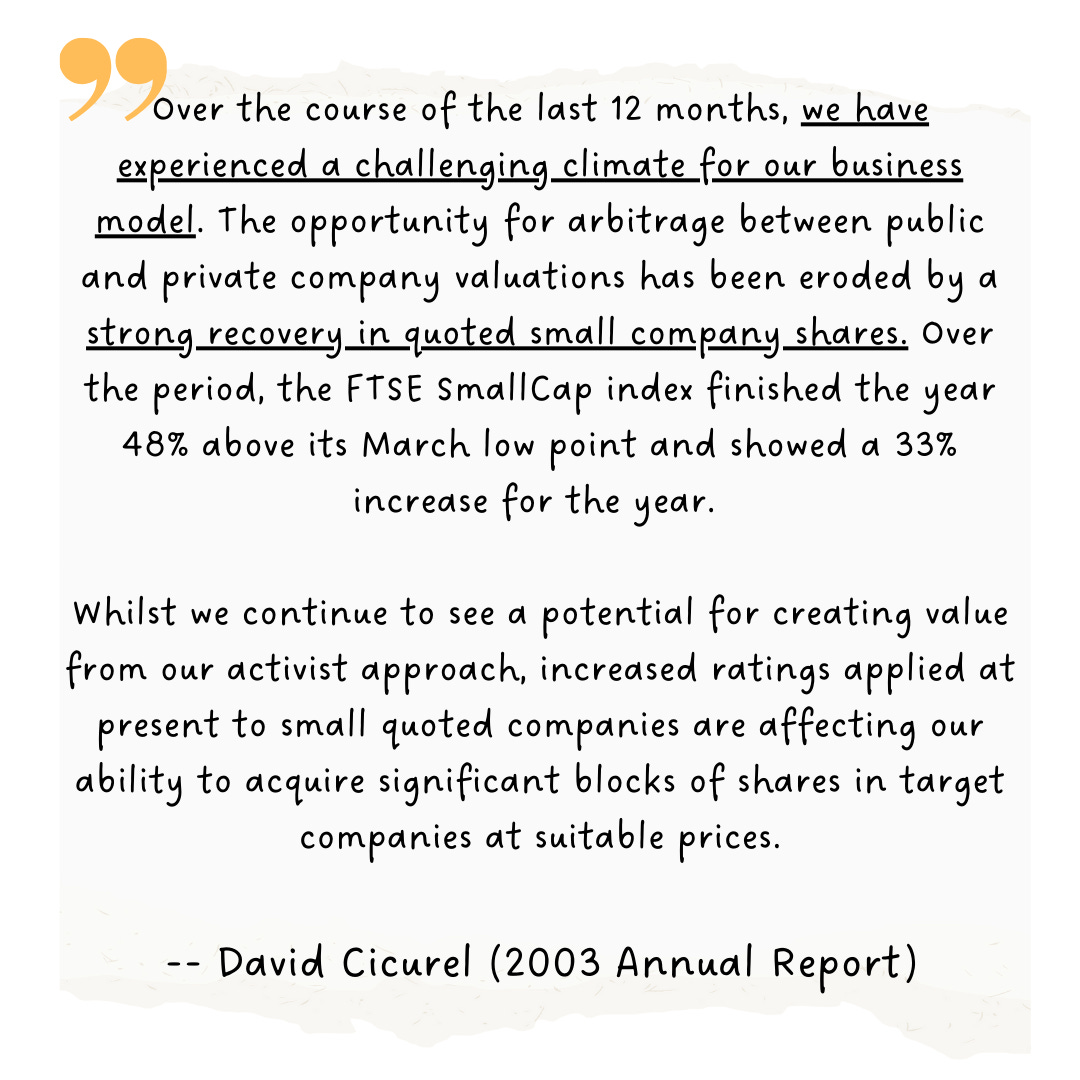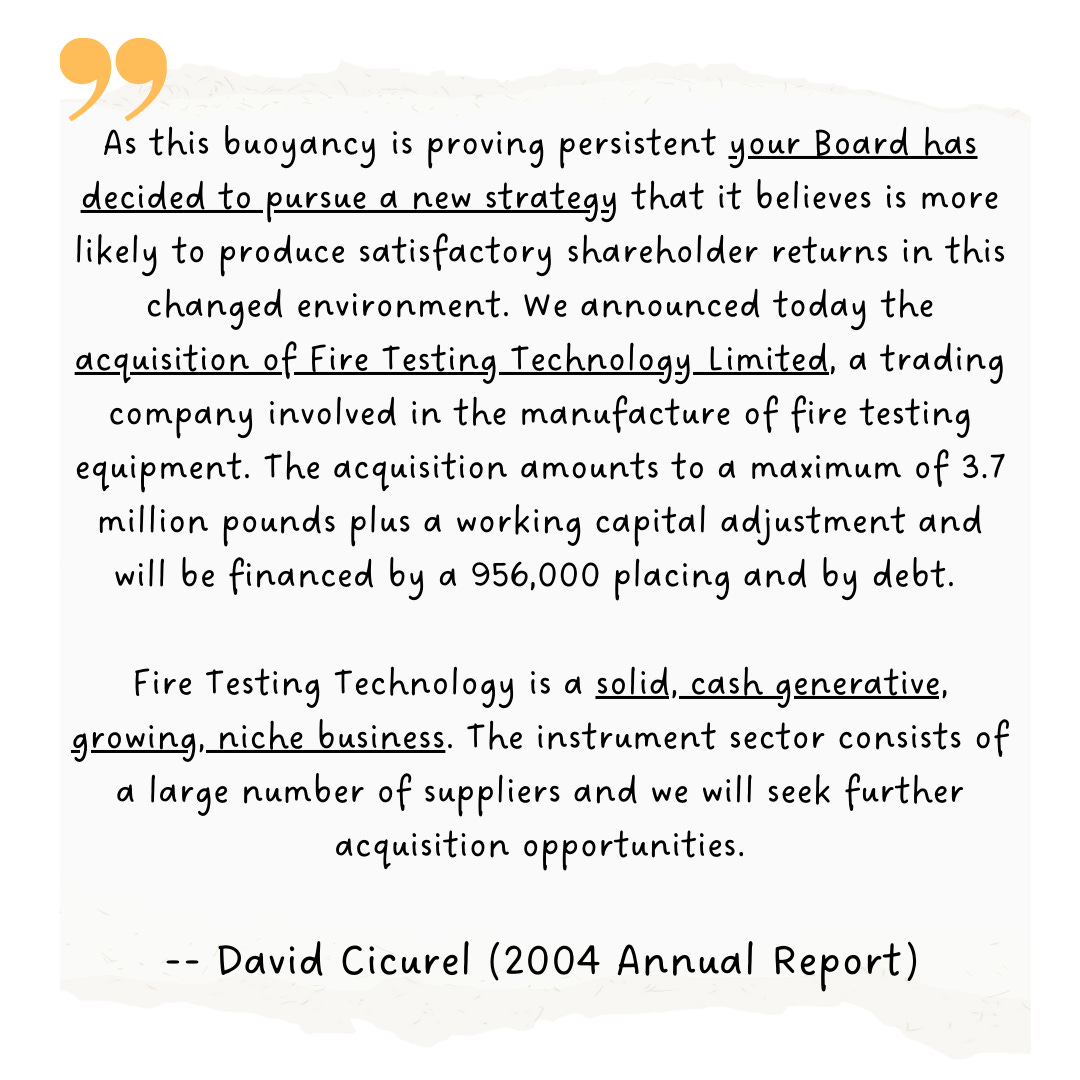Judges Scientific (JDG.L)
Niches Bring Riches
Hi there and welcome to yet another in-depth report.
This time I’ll talk about Judges Scientific (JDG.L), a small cap british company that’s currently 30% off ATHs and with one of the best capital allocators in our generation at the helm.
As a free subscriber you get to read the section on the history and a portion of what the company does. Paid subscribers get access to a 30+ page report that covers all the relevant topics, like management, capital allocation, and the valuation. This report is available in PDF form (as a paid subscriber you can find this around the middle of the first section).
I hope you enjoy the report!
Have you ever heard of a company that was founded with a strategy in mind that’s completely the opposite of the strategy it executes today? If you have not, buckle up because this will be your first time; this is the story of Judges Scientific (‘Judges’ from now on).
David Cicurel (current CEO) founded Judges in 2003 together with Alex Hambro (current Chairman) as an investment vehicle. The company was listed in the UK’s AIM junior exchange and had an initial capital of £2 million, which it aimed to deploy acquiring stakes in small publicly traded companies. The initial strategy was straightforward: buy small public companies, improve them through activism, and take them private to take advantage of the private/public valuation disparity that existed at the time. Cicurel had been involved in a public-to-private deal and was drawn to the arbitrage opportunity that existed; many publicly traded companies were grossly undervalued compared to their private counterparts.
Unfortunately (or fortunately in hindsight), this strategy became obsolete soon after Judges was founded. The post dotcom bubble burst period was one in which publicly traded small-cap companies performed spectacularly well (at least relatively speaking). From 2000 to 2005, the Russell 2000 appreciated by 35% compared to respective drops of 9% and 54% in the leading large-cap indices. Small-cap companies were in favor again, and this was terrible news for Judges:
The public to private arbitrage that Judges planned to exploit had turned on its head in a matter of 12 months:
Like any outstanding capital allocator, Cicurel decided to adapt to the new environment rather than continuing to plow money into a disappearing arbitrage opportunity. This pivot was the consequence of the deteriorating climate but also sheer luck (which is always an important factor behind any business’ success).
Judges had acquired a company called Fire Testing Technology (‘FTT’) in 2005, and it was FTT that made Cicurel realize they had just found a gold mine in private markets: scientific instruments. Cicurel saw a lot of potential in a market composed of hundreds of niches that were typically dominated by just a few players:
FTT made Cicurel realize that the scientific instrument sector was an opportunity for Judges to dominate the world (in a given niche) in exchange for “a couple of million dollars.” Cicurel enjoyed the prospect of becoming the prince of a small castle rather than fighting to be the king of a much bigger empire. The scientific instrument sector seemed like a natural fit for Judges considering that the UK was a fertile ground, probably due to its long-standing investments into scientific research. Judges’ management team sized the opportunity as “+2,000 potential targets just in the UK.” Of these targets, around 100 change hands every year. Judges’ management seriously looks at 1 or 2 deals per year, meaning that the company barely needs to convert around 1-2% of the active funnel to satisfy its inorganic needs (i.e., they can be very selective).
Judges then sold its existing portfolio of public companies and focused entirely on acquiring companies akin to FTT. FTT, by the way, turned out to be a superb acquisition. Judges acquired the fire testing company for a 5x EBIT multiple, and it has compounded its EBIT at a 4% CAGR over the past two decades. A 4% CAGR might fall short of high-growth investors’ expectations, but the reality is that at a 5x EBIT multiple, you don’t need much growth to make the numbers work!
Judges Scientific has conducted 24 additional acquisitions (post FTT) in various scientific instrument niches. The best acquisition (by far) took place in 2009 when the company acquired Quorum, a manufacturer of sample preparation instruments used in electron microscopy. Judges paid 3.3x EBIT for a company that compounded its EBIT at a 16% CAGR over the following 15 years! While Quorum was by far the company’s most profitable acquisition, there have also been a couple of flops (I’ll discuss them in more detail in another section).
The Global Financial Crisis enabled the acquisition of Quorum and an uncompleted acquisition that could’ve changed the company’s fate. In 2008, Judges almost acquired a Hong Kong-based company that would’ve doubled Judges’ size at the time. David Cicurel and his team were unable to pull this off because Lloyds (Judges' long-term bank partner) almost went bust during the crisis and could not provide the company with the required funds. While both of these examples (Quorum and the HK-based company) might portray that Judges can be a countercyclical acquirer, the reality is quite different: the company acquires good companies, and these don’t tend to go on sale through periods of temporary weakness. Judges’ organic business, however, tends to be pretty resilient during tough times (as I’ll explain more in detail later).
Section 1: What Judges Scientific does
Judges is a serial acquirer of scientific instrument companies. The strategy is straightforward: use debt to purchase private companies in the scientific instruments sector at a reasonable valuation (Judges has historically acquired at an average of 5x EBIT), use their cash flows to pay down the debt incurred to finance the acquisition, and repeat the process over and over again. This acquisition model is typically known as the buy-and-build model (B&B), although David Cicurel explains that Judges doesn’t follow the “typical” B&B model that other serial acquirers follow.
In a typical B&B model, serial acquirers will arbitrage multiples by purchasing companies at lower multiples than the one they carry. This, however magical it may seem, means that they are automatically adding value when the profits of the acquired company are consolidated into their operations and valued at a higher multiple (works well so long as there’s no multiple derating!)
Say a company trading at a P/E of 20 acquires a company valued at a P/E of 10 that generates $200 million in earnings. While this $200 million in earnings supports a market cap of $2 billion in the standalone company (200 x 10), it will support a market cap of $4 billion when consolidated under the acquirer (so long as the multiple doesn’t de-rate). This multiple arbitrage might explain why some roll-ups have historically fared well (so long as acquisitions were not transformational).
David Cicurel points out that this is not what Judges does, or at least not the core of the company’s strategy. According to the CEO, Judges focuses on acquiring businesses on the cheap without needing to take advantage of the multiple arbitrage to add value:
While I understand what David is trying to say here, it’s undeniable that Judges takes advantage of both value-additive levers: buying cheap and multiple arbitrage. The stock has traded at an average EV/EBIT multiple of 24x since 2017 and has made acquisitions at an average multiple of 5x EBIT. Let’s see what this means with an example.
If Judges acquires a company for £10 million at a 5x EBIT (EBIT of £2 million), it “automatically” adds around £40 million of value when that EBIT is revalued at its multiple. This model is incredibly (almost magically) profitable so long as the music keeps playing. In Judges’ case, returns are good even if the music stops because the company doesn’t need the multiple arbitrage to make money even though it does benefit from it.
There’s always a temptation to compare any serial acquirer to Constellation Software. However, this report should reveal significant differences between the strategies of both companies. One thing they do have in common is that they both publicly share the gold standard for their preferred acquisitions. Constellation’s standards are more abstract…
An outstanding manager
Consistent profitability
Above average growth
…than Judges’:
25% EBIT margin
Operating in a niche with a dominant position
Average purchase price of 5x EBIT
One difference between Constellation and Judges is that, while Constellation acquires (sometimes) bad businesses that it plans to turn around, Judges focuses on acquiring great businesses. This is quite ironic considering that David Cicurel was once a turnaround specialist!
So, now the question is: What do scientific instrument companies really do? The scientific instrument market comprises thousands of small—to—mid—sized companies that provide equipment for all kinds of scientific applications.








